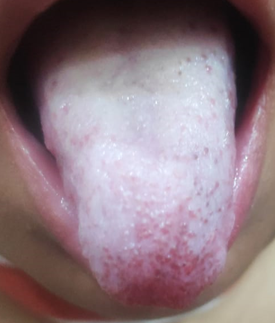AN ORGAN OF TASTE AND HOMEOPATH
- Richa Agarwal

- Jul 27, 2023
- 4 min read
INTRODUCTION
The organ of taste is essential organ for speech, it helps in chewing and swallowing and it keeps the mouth moist. It acts as a mirror that reflect the body’s internal organ, its condition and overall health. It portrays conditions that are more deep seated, systemic or chronic.
Tongue has been used for diagnosis since ancient times by many physicians even by acupuncturists and herbalists. The Chinese medicine considers tongue as a map that corresponds to different parts of the body. According to the Greek medicine taste or the gustatory faculty has an inherently sanguine temperament. Regions or zones of tongue are representation of different internal organs of the body. These reflex zones plays a great role in tongue diagnosis. If abnormalities of tongue coat or colour or an abnormal lesion occur in certain reflex zone, it indicates a build-up of morbid disturbance or analogous structural or nutritive change in corresponding internal organ.
EXAMINATION OF TONGUE WITH HOMEOPATHIC APPROACH
To check the condition of the patient (acute, transient or superficial) examination of the tongue body and tongue coat or moss is needed. It’s important to examine size and shape, condition – congenital/acquired, pale/pink, dry/moist- associated with salivation, papillae, indentation, discolouration (Pigmentation, cyanosis, Coating), inflammation, excoriation, exfoliation, suppuration, gangrene, eruption, growths- including warts, cancer and ranula, varicosity of veins, movement- including paralysis.
The rough and dry tongue indicate dry temperament, flourishing phlegmatic and sanguine humors with Psora in the background. Such tongue conditions are usually inherited or congenital. It can be compensated by one’s lifestyle, hygiene and regimen. Stress or nervousness before addressing an audience or before an examination may cause dry tongue, whereby homoeopathically, Argentum nit. 6c can be prescribed, night before and 1 hour before the event. Also other remedies like Gelsemium 6, Merc cor 30C can be considered.
Smooth and wet tongue indicate wet temperament. Smooth, pale tongue may suggest a nutritional deficiency and kali phosphoricum 6x can be the remedy. Swollen and enlarged tongue indicates that body is retaining excess fluids or is referred as cold wet phlegmatic temperament. If swollen flabby tongue where teeth leaves mark then syphilitic character indicates Mercurius solubilis 6c.

Fig.1 Swollen flabby tongue where teeth leaves mark

Fig.2 Swollen and fiery red triangular tip
Swollen and fiery red triangular tip indicative of Rhus Tox as a remedy. A rumpled tongue indicates a sluggish, inefficient digestion and digestive enzymes. A raw tongue is generally a sign of advanced consumption, deficiency heat and a severe depletion of the vital fluids. Cracked tongue is generally a sign of chronic nervous stress and tension. Midline crack represents the spinal column. It may be sycotic or syphilitic.

Fig 3. Midline crack
Fleshy, robust and neither too fat nor too thin tongue is normal. A very thin emaciated tongue indicates a disease or condition of depletion or deficiency and a generalized malnourishment of the organ and tissues.
Colour of the tongue indicates general condition of the blood and blood stream and basic balance of humors and nutrients. White pale tongue indicates excess of cold phlegmatic humors in the blood stream and hence the condition anaemia. If it’s white with elevation and bad, slimy taste, white thrush tongue, Kali carbonicum 6x, Kali muriaticum 6x, Bryonia alba 6c and Taraxacum 6x might be useful.
For white patches, Taraxacum 2x can be prescribed Bright red tongue indicates more acute or excessive heat, much similar to strawberry tongue of belladonna. A dark red tongue is a sign of dyscracia of the blood. A red sore swollen tongue indicates excess of blood where as smooth tongue accompanied by redness and soreness indicates anaemia, in particular iron deficiency anaemia, and with an earthy taste, remedies indicated may be Ferrum Phosphoricum 6X, Opium 30C, Pulsatilla or Rhus Tox. Purple tongue indicates cyanosis, medicine indicated are Lachesis 30C and Petroleum 30C.Yellow indicates excess of bile, Chelidonium majus 30C can be given, if liver problem is suspected. Brown tongue indicate excess of black bile, Arsenic Album 6C and Baptisia 6C can be thought of. If tongue is black or blackish Mercurius sol 6C, Carbo veg 6C or Arsenic Album 6C can be considered. If black at the centre phosphorus 30c is indicated remedy. If tongue is blue give Antimonium tartaricum 6X or Arsenic Album 6X can be considered. Discoloration of tongue mostly comes under latent Psora.
The moistness of the tongue indicates about the state of hydration of the body. The tongue coats indicates the current condition of the patient’s digestion and metabolism.
Hairy tongue is provoked by poor oral and general health. Mapped tongue points towards diabetes, psoriasis, seborrheic dermatitis and atopy. Fissured tongue has been associated with Down syndrome, acromegaly, psoriasis, seborrheic dermatitis and atopy.
Median rhomboid glossitis (MRG) is a condition with smooth nodular red areas in the post mid line of the tongue. Predisposing factors associated with MRG are smoking, denture wearing, diabetes mellitus and candida infection.
A deviated tongue often associated with facial palsy or paralysis and may be due to apoplexy, convulsion or shock. Tremors are noted in nervousness.
Most common type of tongue ulcers is the canker sore that arises from viral infection, injury to the tongue or even oral cancer.
CASE TAKING & REMEDY SELECTION
Tongue findings help in constructing the patient’s portrait and promotes individualization. It help in remedy selection where the tongue symptoms are characteristic. By examining the tongue underlying temperament of the patient can be known which further helps in deciding the course of treatment and making the disease diagnosis.
Tongue help in selection of remedy in small children deaf and dumb persons.
Tongue findings come under physical general symptoms as they tell us the true and full story of the patient.






Comments